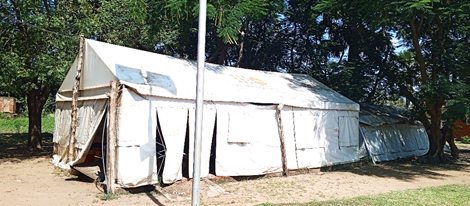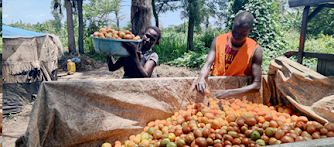DRDIP Kiryandongo, World Bank Field Mission
Three
high level recommendations came out of the two-day visit that marked the beginning
of this year’s World Bank Mission for the Development Response to Displacement
Impacts Project (DRDIP) in Uganda. Sub project sites in Kiryandongo district in
the Bunyoro Sub region were jointly visited by representatives from the World
Bank, Inspectorate of Government(IG), DRDIP project Staff from the Office of
the Prime Minister and key district stakeholders.Mary Kebvin Akisa, the group CPMC explains briquettes making to visiters
While
addressing a feedback meeting session at Kiryandongo district headquarters Monday
14th, February 2022, the World Bank Technical Team Lead (TTL) Fatima Naqvi advised
on the need for DRDIP Uganda to strengthen sustainability efforts for the sub
projects that are benefiting the host communities, noting that the additional
funding majorly focuses on supporting the refugee communities.
Ms
Naqvi further emphasized the need for maximum integration of the different project
components. “Let’s ensure as much as possible to create linkages of the
different components to maximize benefits and avoid working in silos”, she told
a team that also had; the Resident District Commissioner, the District
Chairperson five and representatives of the district technical wing headed by
the Chief Administrative Officer.
Finally,
the TTL urged the IG team to support the project by strengthening the Community
Monitoring Groups so as to augment transparency and accountability. She said
the structures need to clearly understand all processes involved in DRDIP sub project
generation and implementation including mechanisms for managing grievances.
On
what she saw while in the field, the TTL described the milestones as “excellent”.
At Kiryandongo II Community Efficient Cooking Stove and Briquettes Sub Project
for Business, Mary Kevin Akisa, the Group Community Procurement Management
Committee Chairperson(CPMC) said, the group
members are the first users of their
products; energy saving stoves and briquettes. The group have already started producing in bulk for sale within their
communities. Proceeds from the sales are used to strengthen the group savings and
loan scheme so as to spread wealth within their households. On sustainability, Kevin
said, Bunyoro is predominantly a maize growing area, adding that the
waste from maize cobs are readily available to be continuously used as raw material.Kiryandongo District multipurpose office block
Asked
why the group chose the sub project,
Stephen Kabingo, one of the group members said owing to the various Government of Uganda awareness
messages on tree
conservation to reduce
environmental degradation, the group wants to set a precedent. He added that
they were trained by the implementing partner and that they are replicating the knowledge gained through
community sensitisation.
The
team also visited Kinyomozi C community tree planting sub project where a group
of 61 members have grown eucalyptus on 10 acres of land. The trees enjoyed a 95
percent survival rate and now provides a beautiful forest cover at eight months.
Additionally, members also invested in apiary as a supplementary activity to
improve on their earnings and strengthen group savings.
At
Bweyale Southern Ward Soya Bean Production & Marketing Strategic Investment
Fund, the group members reported that the milling machine plant is gaining
steady progress. “We were slightly affected by the COVID-19 lockdown, but now
with the opening of schools this machine has been giving us monthly net profit
of UGX1,200,000”, said Joseph Okony the group CPMC chairperson.
The
team also visited Kanyadoli Health Center II where a complete maternity ward with
sanitary facilities; latrines water installations were constructed by DRDIP at a
cost of Ugsh620,000,000. Pauline Lakot the
in-charge told visitors that the structure will promote healthy delivery by
mothers from both host and refugee communities.
Another
infrastructure investment visited was Kigumba Muslim Primary School where
three classroom blocks, a five stance latrine, water harvesting systems were
erected at a cost of Ugsh230,000,000. The school head teacher, Moses Kalulu said
the new structure has reduced the pupil-classroom ratio from 110 pupils per
classroom to now 45 pupils per classroom. Mr. Kalulu expects a spike in
academic performance due to improved learning environment, adding that teachers
too are motivated to teach in the decent classrooms constructed by the project.
Both host and refugee children attend Kiryandongo Muslim Primary School.
Kiryandongo
District Chairperson Five, Hon. Edith Aliguma thanked the team for visiting and
for the valuable feedback. She noted that the district will work through the
marketing department to support the marketing of products; briquettes and
energy saving stoves that groups are already producing. Aliguma noted that
Kiryandongo hosts not just asylum seekers from other countries but internally
displaced persons especially those who relocated from northern Uganda during
the LRA insurgency. Meanwhile the RDC,
Mr. Mucunguzi Geofrey Ateenyi assured the team of continued team work by Kiryandongo
district leaders to ensure successful implementation of all DRDIP sub projects.





Comments
Post a Comment